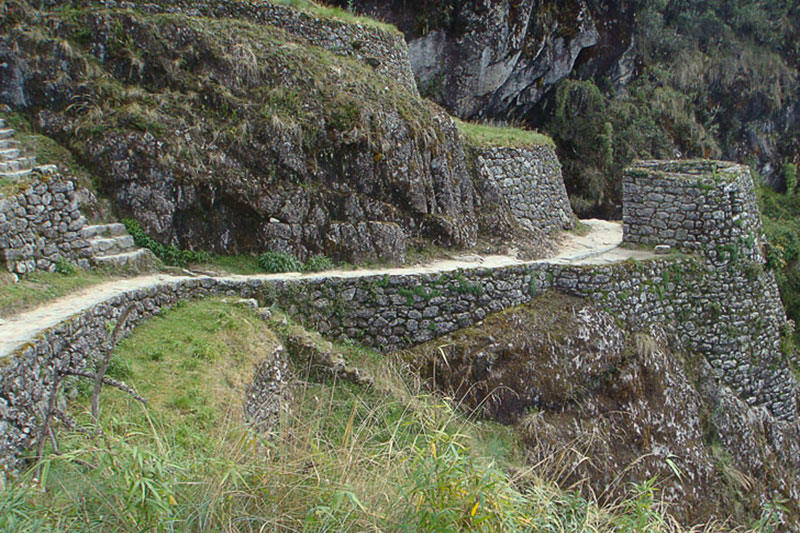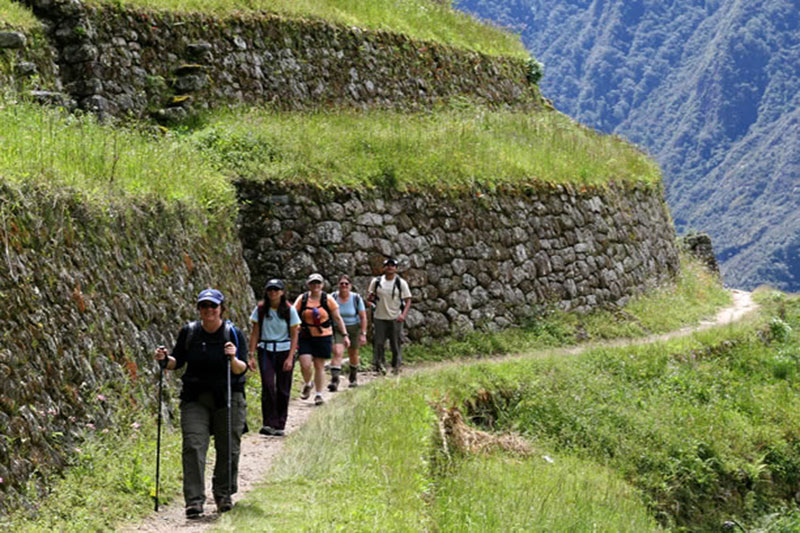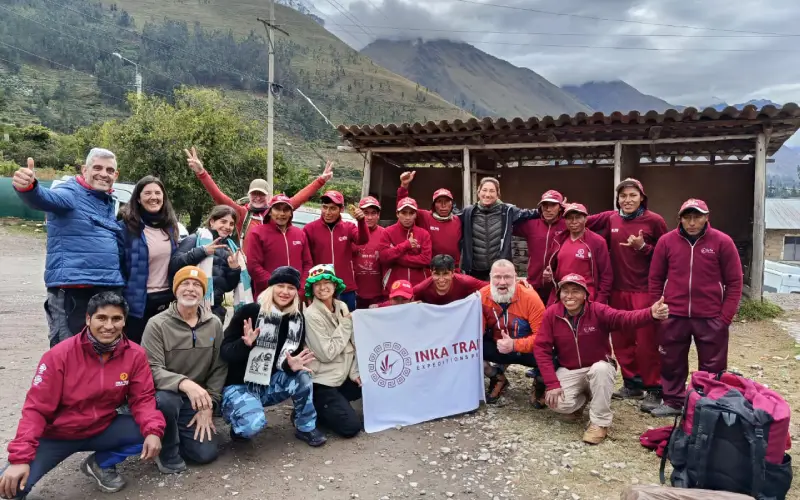The Inca Trail is one of the top 5 hikes in the world, and Machu Picchu is the final point of this amazing journey. This trekking route is the most incredible way to have your first view of the Wonder of the World, just as the Incas did almost 600 years ago.
1 – When should you book the Inca Trail to Machu Picchu?
The Inca Trail is one of the best hikes on the planet. Because of this, there is high demand for tickets. You must book far in advance.
Keep the following in mind before booking your Inca Trail ticket:
- Tickets for the Inca Trail sell out 6 months in advance. Remember that only 500 people can hike this route each day.
- Only 200 hikers will enter Machu Picchu via this route, since the rest are support staff: cooks, porters, and guides.
- The Inca Trail ticket only includes Machu Picchu. If you want to climb Machu Picchu Mountain or Huayna Picchu, you must request it through the tour agency.
- Tickets for the Inca Trail are purchased through an authorized travel agency’s website.
Any Inca Trail tour must include: entry to Machu Picchu, cooks, porters, camping, a tour guide, and return transportation to Cusco (by bus and train).
2 – How long is the Inca Trail hike?
The Classic or Traditional Inca Trail is 40 kilometers (25 miles) long and takes 4 days of hiking (approximately 18 to 24 hours in total). The route will take you through mountains until you reach Machu Picchu, located in Peru’s Amazonian cloud forest.
Facts about the Inca Trail trek:
- The route passes archaeological sites such as Llactapata, Runkurakay, Sayacmarca, Phuyupatamarca, and Wiñaywayna.
- The end of the trail is the Intipunku (Sun Gate) entrance to Machu Picchu—the main gateway in Inca times. The scenery there is breathtaking.
- In most cases, after completing the Inca Trail, you’ll return to Cusco by train.
- The only way to do the Inca Trail is to book a tour through an authorized travel agency.
- No tourist can hike the Inca Trail without a permit. Travel agencies are responsible for securing the permit for you.
3 – What is the highest point on the Inca Trail?
The Inca Trail is considered a challenging trek not only due to its distance but also because of the altitude at certain points. The highest point is Warmihuañusca Pass at 4,224 meters (13,860 feet).
Tips for dealing with altitude on the Inca Trail:
- Altitude sickness (soroche) is common in high-altitude locations. Symptoms can include headaches, nausea, loss of appetite, and fatigue.
- The best way to prevent altitude sickness is to acclimatize in Cusco or the Sacred Valley for a few days beforehand.
- Toward the end of the trail, you’ll also pass lower-altitude spots like Intipata (2,743 m), Intipunku (2,700 m), and Machu Picchu itself (2,400 m).
- An effective way to combat altitude sickness is to drink coca tea or chew coca leaves, as the Incas did hundreds of years ago.
- Tour guides are very experienced in handling altitude issues and can assist hikers if needed.

Restos Incas en el Camino Inca
4 – Can I hike the Inca Trail on my own?
Access to the legendary Inca Trail is strictly controlled to protect the 500-year-old trail and its surrounding natural environment.
Additional information about permits:
- The Inca Trail can only be done with a licensed tour guide. Tickets are purchased through an authorized travel agency.
- The agency will handle booking your ticket and arranging everything necessary for your trek.
- Permits must be reserved 6 months in advance, as spots are limited to 500 people per day.
- Among those 500 people are cooks, porters, and guides, leaving only 200 tourists to enter Machu Picchu via the Inca Trail each day.
5 – Is the Inca Trail open year-round?
The Inca Trail is closed in February. During this month, heavy rains make the trek difficult, and park staff take the opportunity to maintain the trail and Inca structures. The rest of the year, the trail remains open.
Alternative treks to reach Machu Picchu:
- Salkantay Trek: A 5-day, 4-night hike crossing the famous Salkantay snow-capped mountain and lush jungle scenery.
- Choquequirao to Machu Picchu Trek: An 8- to 9-day hike connecting Cusco with two of the most stunning Inca archaeological sites.
- Lares Trek: A 4-day, 3-night trek through high-altitude landscapes, ending at Machu Picchu.
- Huchuy Qosqo Trek: A shorter, easier trek of 3 days and 2 nights covering 17 km, perfect for families.
6 – What is the best time to hike the Inca Trail?
Cusco and southern Peru have two main seasons: the rainy season (November to March) and the dry season (April to October). The best time to hike the Inca Trail is during the dry season, when the weather is warmer and rainfall is less frequent.
What to pack depending on the season:
- Dry season: Bring a hat, sunscreen, insect repellent, sunglasses, light clothing for the day, and warm clothing for the nights.
- Rainy season: Bring a rain poncho, windbreaker, non-slip shoes, and trekking poles.
Temperatures on the trail can reach 25°C (77°F), and mosquitos can be abundant during the dry season.
7 – Does the trek have to be 4 days?
There is a short version of the Inca Trail that lasts 2 days, ideal for travelers with limited time. This version often includes a comfortable overnight stay instead of camping.
More details about the alternative Inca Trail:
- There are many alternative treks to Machu Picchu (e.g., Salkantay Trek, Lares Trek), but only the Inca Trail enters Machu Picchu through the Sun Gate (Intipunku).
- The 2-day Inca Trail covers 12 km (7.5 miles) and reaches Machu Picchu via Intipunku. Hikers spend the night in Aguas Calientes before visiting Machu Picchu the following day.
- Availability for the short Inca Trail is less competitive and can often be booked 2–3 weeks in advance.

Turistas en el Camino Inca
8 – Is the Inca Trail dangerous?
The Inca Trail is not dangerous. Safety measures include first aid kits, and guides are trained to handle emergencies.
Potential risks on the trail:
- The paths are wide and well-marked. Never stray off the trail to explore on your own.
- Many hikers worry about altitude sickness, but symptoms typically subside once acclimatized.
- Older adults may feel the physical strain more intensely and should consult a doctor before hiking.
- Children should always be supervised. It’s recommended that kids enjoy outdoor activities and hiking before attempting this trek.
9 – Can I hike the Inca Trail with children?
The Inca Trail is open to people of all ages. Children and teenagers can join the hike as long as they’re accompanied by their parents. It’s best if minors already enjoy long hikes and camping.
Tips for hiking the Inca Trail with kids:
- It’s not recommended for children under 8 unless they have prior hiking experience.
- The trek is not suitable for babies.
- Prepare children mentally for the challenge before the trip.
Are there restrooms on the trail? Yes. Facilities are available at the three main campsites. Most are squat-style toilets, and only the last campsite has showers.
10 – How much does the Inca Trail cost?
The Inca Trail tours are organized in groups of up to 16 hikers, often from different countries, ages, and cultures.
Prices vary by travel agency, but on average, the 4-day tour costs around $600 USD per person.
How to get the best price:
- Most agencies offer $20–30 discounts for university students with a valid student card (ISIC cards are not accepted).
- Minors under 18 also receive discounts by presenting a passport that confirms their age.
- Some agencies provide discounts for citizens of Peru, Colombia, Ecuador, and Bolivia.
- For private service, the price depends on the group size—the larger the group, the lower the cost per person.
